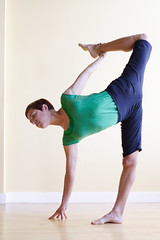What follows is an overview of the general practice of Hṛdaya Yoga (Hridaya Yoga). How long you spend on each of these steps will depend on numerous factors. Such as how long you have available for practice; what your state of being is on the day in question; what emerges from the Unknown; etc. For this reason rigidity is best avoided. The Heart knows no dogma, and yet to balance this we recognize the manifestation of the Heart within the world thrives within a healthy sense of definition and discipline. The definition comes about through your dedication to being Present. Present to your body, to your breath, to the sensations and perceptions arising and passing away within you physically, emotionally, spiritually. This, in itself, is a moment-to-moment discipline—discipleship to That which is within.
Time frame
Steps 1 to 4 will generally take about 15% of your practice time.
Step 5 will take about 40% of your practice time
Step 6 and 7 require about 20%
Step 8 and 9 are interchangeable are take the remaining 25% of your time.
These times are a general outline and are flexible. As you deepen into your practice it is likely step 9 will take an increasing proportion of your total practice time. As you dissolve into deeper states of meditation, the time you spend there will likely increase. Also, as the body opens more fully, the time spent performing asana (Step 5) will at times be very short. Asana is only performed to aid deep meditation. If deep meditation begins to spontaneously arise after just a few minutes of asana, it is not necessary to dwell on asana. You can move directly into meditation, in accordance with what is arising within you.
1. Connection, Commitment, and Gratitude
We begin within connection to the inner elements of our human form, and the world from which that human form arises, and from which it is comprised.
Gentle awareness of breath, as you deepen into the body. Coming down from the head space, connecting deeply into the body-mind space below the navel, whilst feeling the expansive spaciousness of the Heart. From here you bring attention to your inherent connection with the Earth. Give attention to the elements of earth, air, fire, water, space. Give attention to the Light of Consciousness from which these elements are ultimately and originally composed. As you enter into relationship with that Light, know you are coming into contact with The Mother. Give thanks to The Mother—the source of the many forms of Life—and rest in the knowing that in every moment She is transmitting to you and through you Her great wisdom. The very wisdom required for your full awakening and liberation (from the darkness of ignorance).
With this sense of connection to Self, to the Earth, and to Life, and The Mother, you are in a suitable position to genuinely give thanks. For some of us the giving of thanks may start out as more of an intellectual act, as opposed to a genuine heart-felt sense of gratitude. When that is the case, it is perfectly okay. We simply imagine feeling grateful, and use the imagine to develop into that feeling. Using as few words as possible, and as much subtle feeling as we can excite into being. The excitation occurs through our intention to be aware of our true nature. Our true nature is pure Light, in a state of continuous bliss.
Gratitude naturally arises from such the embodiment of our bliss.
2. Dedication
Having connected deeply within, we dedicate our practice to the benefit of all beings and all Life in all realms. Use the inner word to guide your attention, and use your feeling to awaken, guide, and deepen your connectedness, your relatedness with Life.
I dedicate this time of practice to the timeless Perfection. I dedicate this practice to the benefit of all Beings in all realms. I dedicate this practice to the furtherance and celebration of Life. I dedicate this practice to the naked wisdom emerging through all my relations, the wisdom that has brought me here and now to this moment of practice. Finally, and ultimately, I dedicate my Spirit and all spiritual practice to the Great Divine Mother (Devi) creator of all-that-is.
Something along those lines is sufficient. More than just words, what is most essential is your own heart-felt sense of dedication, whilst using whatever words help guide, cultivate, and support that. You may find it helps to deepen your dedication if you focus your attention on the inner source of the words and feelings of devotion and dedication. From where do these words and feelings arise? In whom are they arising? To where do they eventually pass away?
3. Gathering Prana
Here we enter into yoga practice.
The most simple method is what in Taoist Yoga is simply referred to as Embracing the Tree stance. Practice this for a few minutes to begin, building your way up to at least 21 minutes (as and when time permits).
Other practices done at this stage are Gathering Cosmic Chi, Gathering Earth Chi, and Consolidating Chi in the Lower cauldron.
4. Activating the flow of prana and the primary channels
The practice done here is Awakening to Spaciousness. You draw your attention into the awareness of all-pervading space or spaciousness. The space around you. The space between your fingers. The space within you, within and between your cells. Entering into the spaciousness of the body, you will attune to the subtle flow of prana within that space. Up the spine, down the front. Also the flow of prana from the heavens to the earth below, passing through a central beam or ray of light.

5. Opening and awakening into the tissues and channels
Here we perform a range of asana, practiced in a way particular to (although not unique to) Hṛdaya Yoga.
In brief: Connection with breath is paramount. The breath leads you in, through, and out of each asana. The breath is the Alpha, Mu, and Omega of each asana. Awareness of spaciousness in, through, and around the physical body is emphasised. Awareness of bodily and spacious symmetry. The balance of feminine and masculine—Yin and Yang—as expressed through your approach to each asana is important. Awareness of your relationship with the cosmic Being know as Surya, Savitr, or (in English) as the Sun. … and so forth.
6. Deep Relaxation
Here we rest into śavāsana. Here is an opportunity to gently work with the mental body (Manamaya kosha) and the wisdom body (Vijnanamaya kosha). This is done through specific use of intention and visualisation.
7. Pranayama
Various breathing exercises and practised at this stage. Alternate nostril breathing being a primary practice. Although other pranayama can be practiced according to your needs at the time. Simply put, here you are using pranayama to consolidate, balance, and stabilise the flow of prana in the body, particularly in the central channel.
8. Mantra and Sound
Steps 8 and 9 and interchangeable. Meaning that mantra and toning may arise spontaneously as an expression of deepening states of meditation, but also as an agent that helps deepen the meditation and open it into different spheres and spaces within your being. Meditation is primary, mantra is secondary.
Now time is spent attuning to the vibration of sound, of the Word. It could be as simple as atuning to Aum (Om). Entering into the Gayatri Mantra may also prove beneficial. If you have received a mantra specific to you and your awakening process, that too would be practised at this time.

9. Meditation
By this stage meditation will be effortless. There will be very little, if any, sense of doing meditation. Rather a meditative state of awareness will likely have been spontaneously and naturally emerging throughout the prior steps. So, now you simply give it your full attention. If spacious and formless meditation is still a challenge for you at this stage, then various meditation practices can be utilised for the purpose of deepening and stabilising your concentration within meditative awareness.
The eight prior steps were all to build a foundation on which meditation is natural, effortless, and spacious. Unencumbered by form, concept, and thought. Meditation within the Heart, within the body, within the navel, in the Earth, and above the head is all possible and appropriate.
The Specifics
The specific methods, techniques, and practices utilised in the above nine step process are taught as part of the various Hridaya Yoga training programs, retreats, and classes.
Keywords: Hridaya, Hṛdaya, Yoga, Practice
